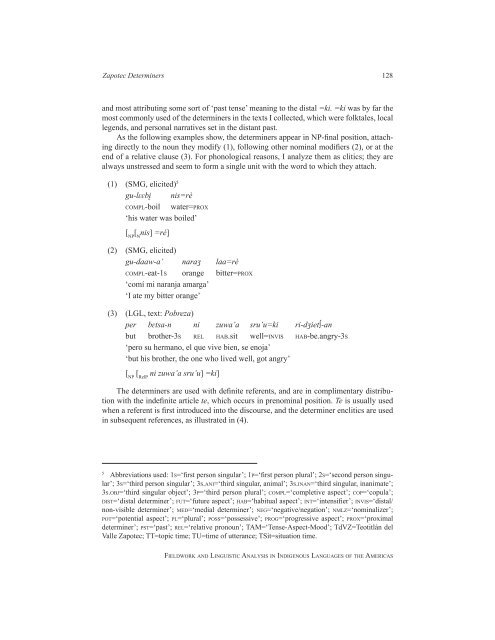Fieldwork and Linguistic Analysis in Indigenous ... - ScholarSpace
Fieldwork and Linguistic Analysis in Indigenous ... - ScholarSpace
Fieldwork and Linguistic Analysis in Indigenous ... - ScholarSpace
You also want an ePaper? Increase the reach of your titles
YUMPU automatically turns print PDFs into web optimized ePapers that Google loves.
Zapotec Determ<strong>in</strong>ers 128<br />
<strong>and</strong> most attribut<strong>in</strong>g some sort of ‘past tense’ mean<strong>in</strong>g to the distal =ki. =ki was by far the<br />
most commonly used of the determ<strong>in</strong>ers <strong>in</strong> the texts I collected, which were folktales, local<br />
legends, <strong>and</strong> personal narratives set <strong>in</strong> the distant past.<br />
As the follow<strong>in</strong>g examples show, the determ<strong>in</strong>ers appear <strong>in</strong> NP-f<strong>in</strong>al position, attach<strong>in</strong>g<br />
directly to the noun they modify (1), follow<strong>in</strong>g other nom<strong>in</strong>al modifiers (2), or at the<br />
end of a relative clause (3). For phonological reasons, I analyze them as clitics; they are<br />
always unstressed <strong>and</strong> seem to form a s<strong>in</strong>gle unit with the word to which they attach.<br />
(1) (SMG, elicited) 5<br />
gu-lɛɛbi̥ nis=rè<br />
comPl-boil water=Prox<br />
‘his water was boiled’<br />
[ NP [ N nis] =rè]<br />
(2) (SMG, elicited)<br />
gu-daaw-a’ naraʒ laa=rè<br />
comPl-eat-1s orange bitter=Prox<br />
‘comí mi naranja amarga’<br />
‘I ate my bitter orange’<br />
(3) (LGL, text: Pobreza)<br />
per bɛtsa-n ni zuwa’a sru’u=ki ri-dʒiet∫-an<br />
but brother-3s rel hab.sit well=<strong>in</strong>vis hab-be.angry-3s<br />
‘pero su hermano, el que vive bien, se enoja’<br />
‘but his brother, the one who lived well, got angry’<br />
[ NP [ RelP ni zuwa’a sru’u] =ki]<br />
The determ<strong>in</strong>ers are used with def<strong>in</strong>ite referents, <strong>and</strong> are <strong>in</strong> complimentary distribution<br />
with the <strong>in</strong>def<strong>in</strong>ite article te, which occurs <strong>in</strong> prenom<strong>in</strong>al position. Te is usually used<br />
when a referent is first <strong>in</strong>troduced <strong>in</strong>to the discourse, <strong>and</strong> the determ<strong>in</strong>er enclitics are used<br />
<strong>in</strong> subsequent references, as illustrated <strong>in</strong> (4).<br />
5 Abbreviations used: 1s=‘first person s<strong>in</strong>gular’; 1P=‘first person plural’; 2s=‘second person s<strong>in</strong>gular’;<br />
3s=‘third person s<strong>in</strong>gular’; 3s.ani=‘third s<strong>in</strong>gular, animal’; 3s.<strong>in</strong>an=‘third s<strong>in</strong>gular, <strong>in</strong>animate’;<br />
3s.obJ=‘third s<strong>in</strong>gular object’; 3P=‘third person plural’; comPl=‘completive aspect’; coP=‘copula’;<br />
dist=‘distal determ<strong>in</strong>er’; fut=‘future aspect’; hab=‘habitual aspect’; <strong>in</strong>t=‘<strong>in</strong>tensifier’; <strong>in</strong>vis=‘distal/<br />
non-visible determ<strong>in</strong>er’; med=‘medial determ<strong>in</strong>er’; neg=‘negative/negation’; nmlz=‘nom<strong>in</strong>alizer’;<br />
Pot=‘potential aspect’; Pl=‘plural’; Poss=‘possessive’; Prog=‘progressive aspect’; Prox=‘proximal<br />
determ<strong>in</strong>er’; Pst=‘past’; rel=‘relative pronoun’; TAM=‘Tense-Aspect-Mood’; TdVZ=Teotitlán del<br />
Valle Zapotec; TT=topic time; TU=time of utterance; TSit=situation time.<br />
fieldwork <strong>and</strong> l<strong>in</strong>guistic analysis <strong>in</strong> <strong>in</strong>digenous languages of the americas

















